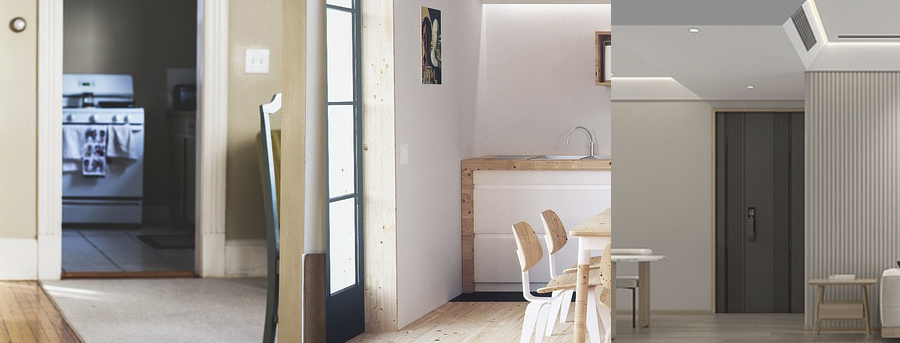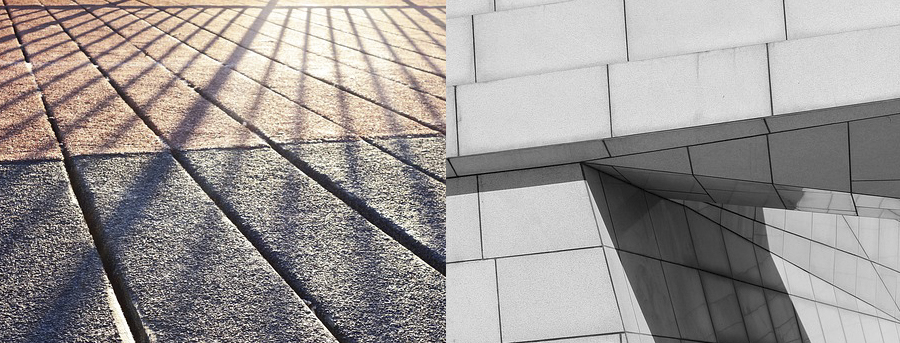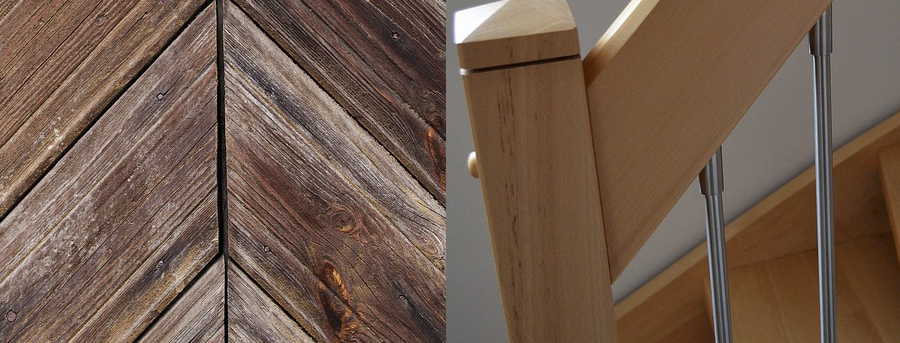Shadow gap
Contents |
[edit] What is a shadow gap ?
A shadow gap (sometimes called shadow line) is simply a gap between two surfaces, elements or materials that creates a darkened area. It can help minimise any imperfections that might otherwise be perceived more clearly were the two surfaces to be abutted directly and may also be needed to allow for movement of the materials from initial drying, such as with plaster or seasonal drying such as with timber boards which may expand and contract between wetter winter months and drier summer months.
[edit] The shadow gap Guggenheim frame
The term shadow gap is also used in picture framing to describe a picture that is inset around a frame, as opposed to the traditional method of the frame covering the edge of the picture (acting in a similar way to a cover strip or edging). The method was said to have first been used in the Guggenheim Museum, where an L section frame is laid underneath the canvas leaving a 1cm gap around the edge on the face and fixed from behind, creating a shadow gap between the exposed edge of the painting and the facing edge of the picture frame. This type of frame might also be referred to as a Guggenheim frame.
[edit] Traditional shadow gap coverings
Alternatives to shadow gaps are in architectural terms might be called cover strips, lips, edges, trims or mouldings. Many traditional architectural features were in effect acting as trims or cover strip alternatives to shadow gaps between two materials prone to movement, for example in Victorian features such as architraves. A architrave is a timber moulding that is fixed around a door frame covering the gap between the wooden frame and the plaster finished wall, it hides any imperfections that may occur between the finish or movement between the two differing materials. During this period these practical detail solutions also became architectural features of decoration matching up different materials or angles and also include cornices (covering wall to ceiling joints),skirting boards (covering wall to floor joints) and so on including all kinds of decorative trims and beads.
[edit] Modernism and the shadow gap
The modernist movement was in many respects all about stripping away what was considered decorative or unnecessary elements of a building, down to the bare essentials, as Le Corbusier would famously be quoted as saying that “modern decoration has no decoration”. In this scenario, the shadow gap may be considered to have been the preferred practical solution to a detail problem over traditional and often even modern forms of cover strips or trims. It is also true that the modernism coincided with increased possibilities in terms of fabricating the elements of buildings, which in turn facilitated greater accuracy and mechanisation. This in some respects helped to reduce tolerances and as such the need to for covers, celebrating architectural features as component parts of a "machine for living" as opposed to decorative features blending into a whole. As such the shadow gap represented the simplest, most minimal and honest way to treat the transition between units, elements, angles and surfaces.
[edit] Shadow gaps today
Today shadow gaps continue to be used as an expression of minimalism, purity and modernism, with design solutions that remove architraves from doors, and skirting from walls, leaving the simplest of lines and a stepping back of surfaces. They can be seen employed in the manufacture of all sorts of household products as well well as exterior cladding features adding to a modern aesthetic but also minimising the number of required components and increasing production efficiency.
[edit] Related articles on Designing Buildings
- Architrave.
- Acroterion.
- Barrel vault.
- Bas-relief.
- Classical orders in architecture.
- Colonnade.
- Corbel.
- Cornice.
- Cornice coving and architrave definitions.
- Door terminology.
- Elements of classical columns.
- English architectural stylistic periods.
- Entablature.
- Fillet.
- Frieze.
- Grommet.
- Lintel.
- Loggia.
- Moulding.
- Pediment.
- Pedestal.
- Pendentive dome.
- Pilaster.
- Soffit.
- Trompe l’oeil.
- Tympanum.
- Window frame.
Featured articles and news
Ebenezer Howard: inventor of the garden city. Book review.
Grenfell Tower fire – eight years on
A time to pause and reflect as Dubai tower block fire reported just before anniversary.
Airtightness Topic Guide BSRIA TG 27/2025
Explaining the basics of airtightness, what it is, why it's important, when it's required and how it's carried out.
Construction contract awards hit lowest point of 2025
Plummeting for second consecutive month, intensifying concerns for housing and infrastructure goals.
Understanding Mental Health in the Built Environment 2025
Examining the state of mental health in construction, shedding light on levels of stress, anxiety and depression.
The benefits of engaging with insulation manufacturers
When considering ground floor constructions.
Lighting Industry endorses Blueprint for Electrification
The Lighting Industry Association fully supports the ECA Blueprint as a timely, urgent call to action.
BSRIA Sentinel Clerk of Works Training Case Study
Strengthening expertise to enhance service delivery with integrated cutting-edge industry knowledge.
Impact report from the Supply Chain Sustainability School
Free sustainability skills, training and support delivered to thousands of UK companies to help cut carbon.
The Building Safety Forum at the Installershow 2025
With speakers confirmed for 24 June as part of Building Safety Week.
The UK’s largest air pollution campaign.
Future Homes Standard, now includes solar, but what else?
Will the new standard, due to in the Autumn, go far enough in terms of performance ?
BSRIA Briefing: Cleaner Air, Better tomorrow
A look back at issues relating to inside and outside air quality, discussed during the BSRIA briefing in 2023.
Restoring Abbotsford's hothouse
Bringing the writer Walter Scott's garden to life.
Reflections on the spending review with CIAT.
Retired firefighter cycles world to raise Grenfell funds
Leaving on 14 June 2025 Stephen will raise money for youth and schools through the Grenfell Foundation.
Key points for construction at a glance with industry reactions.



























Comments
[edit] To make a comment about this article, click 'Add a comment' above. Separate your comments from any existing comments by inserting a horizontal line.